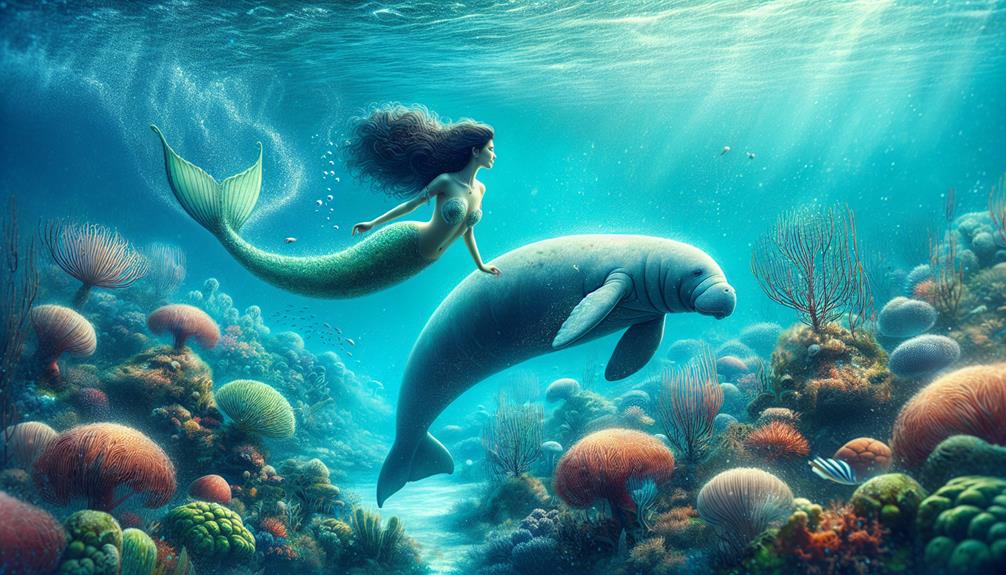You may have heard the tale of Christopher Columbus mistaking manatees for mermaids during his voyages to the New World.
But have you ever stopped to consider the fascinating similarities and differences between these two aquatic beings?
As you explore the origins and folklore surrounding mermaids and manatees, you'll uncover surprising connections that may challenge your preconceptions about these legendary creatures.
Origins and Folklore
The origins and folklore of mermaids and manatees intertwine in ancient tales and maritime lore, shaping the cultural perceptions of these mysterious creatures.
The folklore origins of mermaids can be traced back to various cultures around the world, from the sirens of Greek mythology to the ningyo of Japanese folklore. These mythical beings have captured the human imagination for centuries, often depicted as enchanting, half-human, half-fish creatures with the ability to lure sailors with their mesmerizing voices.
Manatees, on the other hand, have also been linked to mermaid folklore, as sailors mistook these gentle sea mammals for mermaids due to their human-like features and graceful movements in the water.
The cultural significance of mermaids and manatees is evident in the numerous stories, art, and legends that have been passed down through generations. The enduring fascination with mermaids has led to their portrayal in literature, art, and popular culture, symbolizing themes of femininity, seduction, and the unknown depths of the sea.
In contrast, manatees, often referred to as 'sea cows,' have been revered in various cultures for their gentle nature and significance as a symbol of conservation. Their presence in folklore reflects the deep connection between humans and the marine environment, emphasizing the importance of coexisting with these gentle giants.
Similarities and Differences
Intertwining their connections to folklore and maritime lore, mermaids and manatees share both similarities and differences in their cultural significance and physical characteristics. Despite their mythical associations, both mermaids and manatees are real creatures with distinct traits.
Similar habitats provide a point of convergence between the two, as both are primarily aquatic. Manatees inhabit shallow, slow-moving rivers, estuaries, saltwater bays, canals, and coastal areas, while mermaids, as depicted in folklore, are often associated with the open ocean.
Dietary differences are another notable contrast between mermaids and manatees. Manatees are herbivores, mainly consuming aquatic plants such as seagrass and marine algae. Their diet is a crucial aspect of their habitat, as they're dependent on the availability of these plant species. Mermaids, on the other hand, are fictional beings often portrayed as hunters of marine creatures or gatherers of underwater treasures. The contrast in their dietary habits reflects the biological realities of manatees and the imaginative nature of mermaids.
Understanding the similarities and differences between mermaids and manatees enriches our appreciation of both the natural world and human culture. While manatees contribute to the ecological balance of their habitats through their grazing habits, mermaids continue to captivate human imagination through stories and folklore. By recognizing the convergence and divergence of these two entities, we gain a deeper understanding of the intricate connections between myth, nature, and human perception.
Frequently Asked Questions
Are There Any Scientific Studies That Have Been Conducted to Investigate the Existence of Mermaids?
Scientific studies have been conducted to investigate folklore beliefs surrounding mythical creatures. Research has explored the ecological impacts of these beliefs, as well as communication methods and geographic connections.
Cultural beliefs have also been examined to understand their origins and significance. While these studies shed light on the cultural and historical aspects of mythical creatures, they don't provide evidence for their existence in a scientific sense.
What Are the Potential Ecological Impacts of Mistaking Manatees for Mermaids?
Mistaking manatees for mermaids can have significant ecological implications. These gentle creatures play a crucial role in their marine habitats, and any misinterpretation could impact conservation efforts.
For instance, a study found that manatee populations are at risk due to factors like boat strikes and loss of habitat. Therefore, it's essential to raise awareness about the distinction between manatees and mythical creatures to ensure their protection and conservation.
Can Manatees Communicate With Each Other in a Way That Is Similar to How Mermaids Are Portrayed in Folklore?
Manatee communication involves a range of sounds and vocalizations, including squeaks, chirps, and whistles, which are used for social interactions and navigation.
When comparing this to folklore, it's important to note that folklore often portrays mermaids as using enchanting vocal communication.
While there isn't a direct similarity, manatees do use vocalizations for similar purposes, such as socializing and maintaining group cohesion, which can be compared to the portrayal of mermaids in folklore.
Is There a Connection Between the Sightings of Mermaids and the Presence of Manatees in Certain Geographic Areas?
Imagine a world where folklore and ecological misconceptions collide.
When delving into the sightings of mermaids, it's crucial to consider the habitats of manatees and the connections to folklore.
By examining the geographic areas where mermaid sightings occur and correlating them with manatee habitats, researchers can shed light on the origins of these tales.
This scientific approach can unravel the mystery behind the folklore and its ecological ties.
Are There Any Modern-Day Communities or Cultures That Still Believe in the Existence of Mermaids or Have Folklore Surrounding Them?
In modern times, various communities and cultures still hold beliefs in the existence of mythical creatures like mermaids. Along with rich folklore surrounding them, these beliefs and stories often carry significant cultural and historical significance. They also influence ethical considerations and conservation efforts in certain regions.
Understanding and respecting these modern beliefs and cultural folklore is crucial for promoting cultural diversity and conservation efforts in areas where these beliefs are held.
Conclusion
In conclusion, the similarities and differences between mermaids and manatees provide a fascinating insight into the intersection of folklore and biology.
While mermaids have captured the imagination of sailors for centuries with their mythical beauty, manatees offer a real-life representation of aquatic grace and gentleness.
Both creatures continue to inspire awe and wonder, serving as a reminder of the mysteries that still exist within the depths of the ocean.

